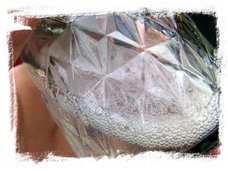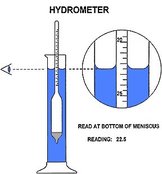 click for larger image
click for larger image
How To Proof Moonshine
How it was done then and how it's done today:
Alcohol proof is a measure of how much ethanol (alcohol) is contained in any alcoholic beverage. The term "proofing" originated way back in the 16th century when payments to British sailors included rations of rum. To ensure that the rum had not been watered down, it was "proved or proofed" by dousing gunpowder with it and then testing to see if the gunpowder would ignite. If it did not, then the rum contained too much water and was considered to be "proved under proof". Gunpowder would not burn in rum that contained less than 57.15% ABV (alcohol by volume). Therefore, rum that contained this percentage of alcohol was defined to have "100° (one hundred degrees) proof". The gunpowder test was officially replaced by a specific gravity test in 1816.
Then came along the old moonshiners who developed and used the simple shake test. It’s an old school technique to test the proof of moonshine and works well if you have the experience. If your just starting out I’d suggest you try this method and then move on to testing it with a Hydrometer, see just how close you were to predicting the Proof of your Brew.
Shake Test Instructions:
Step 1 – Shake up a Mason Jar bottle of Moonshine
Step 2 – Watch how fast bubbles dissipate at this point your checking the “bead” (see picture)
The faster the bubbles disappear the higher the content of alcohol. For example a bottle of 80 proof Moonshine when shaken will have small bubbles that will disappear after several seconds. Where as a bottle of 180 proof Moonshine will have large bubbles that will disappear instantly. You will obviously have to practice the Shake test many times before you can accurately predict the Proof of Moonshine.
Today the best way to proof any alcoholic beverage is to use a Hygrometer. So What Is a Hydrometer and how do I use the dang thing?
A Hydrometer is merely a tool used to determine how much alcohol is in our mash. The majority are simple glass tubes that are sealed at both ends and weighted or ballasted at the bottom for correct buoyancy. There is a graduated scale within the glass tube. It basically measures the density of any liquid in relation to water. There are 2 types of hydrometers that are used in conjunction with moonshine, brewing and distilling. If you are looking to distill spirits you should own both a brewing hydrometer and a spirit hydrometer as they are both calibrated differently. You can't use a brewing hydrometer to measure the final proof of your distilled product and you can't use a spirit hydrometer while making your mash. This article will focus on the proper use of brewing and spirit hydrometers.
As an example, if a thin mash batch for corn whiskey that was boosted with some extra sugar and the OG was 1.090 and the FG was 1.010. Here's how to determine the alcohol percentage of the wash:
1.090 minus 1.010 equals 0.08.0.08 X 131= 10.48The wash is 10.48% alcohol.
Some recipes will produce lower starting alcohol and some will produce higher. Starting alcohol as high as 20% can be achieved if a ton of sugar is used in combination with turbo yeast. However, recipes with a starting alcohol in the 5 - 8% range will actually produce a much better tasting final product than recipes with 10% or higher starting alcohol content.
To test the finished product from your moonshine still float a Proof and Tralle hydrometer in the spirits. This type hydrometer is used to calculate proof in higher alcoholic beverages such as spirits and liqueurs. The scale goes up to 200 proof and therefore it is not accurate for lower alcohol products like beer or wine.
BTW As a reference point I wholeheartedly recommend the book Moonshine written by Matthew B. Rowley that can be found in our book department. The book Moonshine is chock full of information. A history of moonshine, plus recipes, how-to's, and much, much more.
It's a fantastic and fun to read book, with an in-depth look at the history of moonshining from the beginning all the way to present day. This book also outlines the basic process from fermentation through to pot distillation, along with how-to's. A number of traditional recipes for Whiskey, Rum, Schnapps, and more.
1.090 minus 1.010 equals 0.08.0.08 X 131= 10.48The wash is 10.48% alcohol.
Some recipes will produce lower starting alcohol and some will produce higher. Starting alcohol as high as 20% can be achieved if a ton of sugar is used in combination with turbo yeast. However, recipes with a starting alcohol in the 5 - 8% range will actually produce a much better tasting final product than recipes with 10% or higher starting alcohol content.
To test the finished product from your moonshine still float a Proof and Tralle hydrometer in the spirits. This type hydrometer is used to calculate proof in higher alcoholic beverages such as spirits and liqueurs. The scale goes up to 200 proof and therefore it is not accurate for lower alcohol products like beer or wine.
BTW As a reference point I wholeheartedly recommend the book Moonshine written by Matthew B. Rowley that can be found in our book department. The book Moonshine is chock full of information. A history of moonshine, plus recipes, how-to's, and much, much more.
It's a fantastic and fun to read book, with an in-depth look at the history of moonshining from the beginning all the way to present day. This book also outlines the basic process from fermentation through to pot distillation, along with how-to's. A number of traditional recipes for Whiskey, Rum, Schnapps, and more.



